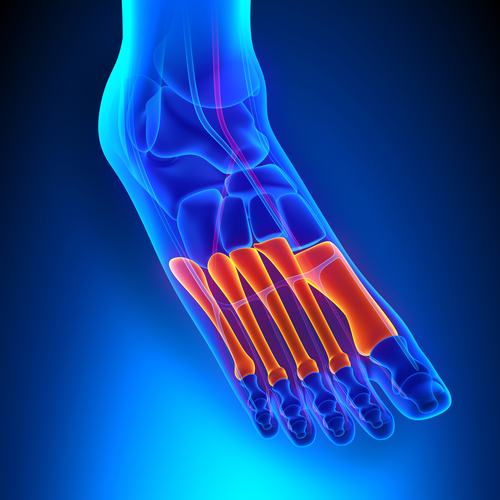“An early-morning walk is a blessing for the whole day.”
– Henry David Thoreau
There is great truth in that statement. However, recurring or chronic foot pain can make it difficult to take that walk. A common example of this is a condition known as metatarsalgia.
Symptoms of Metatarsalgia

Metatarsalgia causes inflammation and usually a sharp or burning pain in the ball of the foot and often in the area near the big toe. In some cases, this pain can be felt around the second, third or fourth toe. The symptoms, aside from the burning pain, can include numbness and a tingling sensation that worsens when the foot is flexed or when the patient is standing, walking or running.
Oftentimes, this pain can be much more intense when walking barefoot on hard surfaces.
Other conditions that can cause similar pain to metatarsalgia include Morton’s neuroma, which is usually experienced as a sharp pain between the second and third, or the third and fourth, toes. Another cause can be sesamoiditis, in which the pain is usually felt under the big toe.
What Causes Metatarsalgia?
Metatarsalgia occurs typically from the foot impacting hard surfaces while walking or running. In addition, improper biomechanics can also affect the way body weight is distributed in the foot. All of this can result in extra pressure on the metatarsal bones, leading to inflammation and pain.
Metatarsalgia also can be caused by the following:
- Intense training or sudden increase in activity level.
- A high arch can put extra pressure on the metatarsals, as can a Morton’s toe, causing more weight being put on the second or third metatarsal heads.
- Hammer toe, which can depress, or drop, the metatarsal heads.
- Bunions can weaken the big toe, putting extra stress on the ball of the foot.
- Obesity or excess weight, which puts pressure on the metatarsals.
- High heels, shoes with narrow toe boxes and athletic shoes that lack support and padding.
- Stress fractures in the metatarsals or phalanges.
Treating Metatarsalgia
Common treatments such as ice and rest can often relieve metatarsalgia symptoms. Also, common over-the-counter pain relievers and anti-inflammatories such as ibuprofen, naproxen or aspirin can help reduce the pain and inflammation.
If you go to a doctor, additional treatments may be suggested, and you may be advised to avoid sports and other strenuous activities while you recover. Usually, lower impact activities are allowed during this time.
In fact, metatarsalgia treatment can often be fairly simple according to the Mayo Clinic,
“Conservative measures — such as resting, changing shoes or using a metatarsal pad — might be all you need to relieve signs and symptoms. In rare cases, when conservative measures don’t relieve your pain and your metatarsalgia is complicated by foot conditions such as hammertoe, surgery to realign the metatarsal bones might be an option.”
But, when the pain isn’t successfully treated at home and has become recurring or chronic, we offer a treatment option that can be very successful and do not require surgery.
Treatment With Anatomy in Motion (AiM)
At Pain and Performance Solutions we believe that treating foot pain with Anatomy in Motion, or AiM for short, is one of the best natural therapies around.
AiM is essentially a complete road map to the structure of the human body. The underlying philosophy Anatomy in Motion is founded on principles of movement that are influenced by our most primal, repetitive, and fundamental movement as humans: walking.
Many techniques such as the SFMA (Selective Functional Movement Assessment), which is a comprehensive movement based diagnostic system, are great for assessing the larger areas of the body, but very few offer the insight into the foot that AiM provides.
According to the AiM website:
“During movement (both fundamental and sporting activities), the joints, ligaments and muscles in your body have a role to play and everything is dependent on all other parts being capable of doing their job to function optimally. When your body reduces movement to protect something, say due to previous injury for example, it exposes other areas which can become at risk – this may or may not be at the site of pain.”
With AiM we can determine your foot’s dysfunction through movements and how you respond to the pain caused by those movements. Through AiM movement treatments, we then learn how to get you away from that pain naturally. This also allows your body to start working properly again and on a path of reaching its full potential.
The AIM treatments access the different ways that your posture contributes to the pain in your feet by the way you are moving. Throughout life, your body learns what movements are right and which are wrong. Yet, the tendency is for it to take the path to least resistance, so that you experience the least amount of pain possible. But this is not always good!
Our overall goal at Pain and Performance Solutions is to help identify what your body is trying to tell you. Pain is obviously uncomfortable and obnoxious, but it’s also good because it’s a communicator. And treating foot pain with AIM therapy is a way for us to really listen to your pain through your movements.
Please don’t go another day not knowing why you are in pain. Let us help to ease your mind by diagnosing the source of that pain. At the very least, we can try and help with that exhaustion because at the end of the day, the brain is the key to all healthy movement. You can contact us by clicking over to our website or you can call us at (707) 636-4404 or fill out our online contact form.